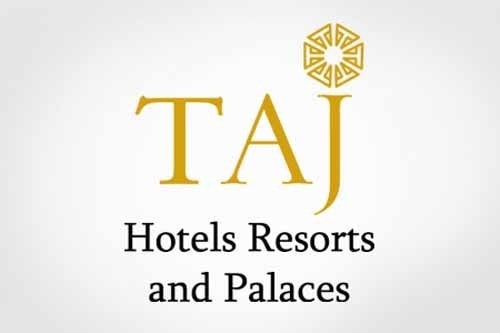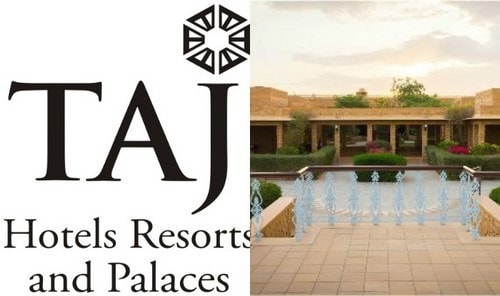Taj Group of Hotels is an international chain of luxury hotels owned by the Tata Group. The hotel chain has around 100 properties across India as well as operations in countries like Bhutan, Malaysia, Maldives, Nepal, South Africa, Sri Lanka, UAE, UK, USA, and Zambia.
The hotel chain registered a net income of USD 9.4 million and employs close to 25000 people in its properties across the world. The hotel chain which was established in the year 1903 was one of the oldest luxury hotels in the region and thus has a rich tradition of hospitality. In addition to hotels, the group also has safaris and resorts under their umbrella.
Their hotels have a host of facilities for guests like rooms, spas, jacuzzi, multi-cuisine restaurants, swimming pools, pubs, resto cafes, fitness centers, and banquet halls. In addition to the hotel business, the Taj Group of Hotels also provides airline catering services in South East Asia.
The hotel chain has a number of properties in key tourist locales making it a popular choice for leisure travelers as well as in all major cities making it a preferred choice for business travelers.
Table of Contents
Strengths in the SWOT analysis of Taj Hotels
Strengths are defined as what each business does best in its gamut of operations which can give it an upper hand over its competitors. The following are the strengths of Taj Hotels & Resorts :
- Catering to multiple segments: The Taj Group of Hotels has something that caters to all segment. While the TajVivanta caters to the upper upscale segment, Taj the luxury segment, Gateway the upscale and Ginger the economy segment. This ensures that irrespective of income status all customers choose a Taj Hotel for their stay.
- Business Philosophy: The business philosophy of the Taj has primarily based on the premise that not everyone is the same. Thus through clearly segmenting the market the hotel has been able to clearly differentiate their offering not just to cater to different income segments but also to different cultures.
- Amenities: The Taj Group of Hotels has a host of facilities in all their hotels. Their hotels have a host of facilities for guests like rooms, spas, jacuzzi, multi-cuisine restaurants, swimming pools, pubs, resto cafes, fitness centers and banquet hall. Some of the their hotels also have mega convention centers with facilities to host conferences for a huge gathering.
- Customer Loyalty programs: Quite unlike other hotel chains who look at loyalty programs in the Taj Group the customer is given a chance to earn points from all stays in all properties of the group. The key feature of their loyalty program is the automatic upgrade to a higher class hotel within the group. For example, a customer who has been frequently staying in a Ginger Hotel may get an upgrade to the TajVivanta or Taj if they have sufficient loyalty points.
- Service Differentiation: The Tajresearch team has identified around 155 touch points in customer service from the moment a customer enters into their property till the time they leave from there where there is a face to face interaction. The hotel chain has ensured that in each of these points there is a clear service difference.
- Focus on the business class: The hotel chain realized the scope for growth in business class travel and thus opened Taj Residency a business class hotel. The hotel chain also moved out to smaller towns and cities and this expansion has helped to increase the customer base of the business.
Weaknesses in the SWOT analysis of Taj Hotels
Some of the key weaknesses of Taj Group of Hotels are:
- Customer Relationships: Hotels today need to be on their toes in terms of customer relationship management. The key to success today is a compilation of information of customers which enables them to understand them better and give personalized services. This is proving to be extremely costly for Taj.
- Unequal growth across segments: While the economy and upper upscale segment were registering good growth, the luxury segment was still lagging. However, the maintenance and upkeep costs of the luxury hotels are relatively higher and the returns low. The hotel has been pumping money from their medium segments for the upkeep of their luxury hotels.
- The high cost of maintenance: The maintenance costs of hotels are growing and with a network of almost 100 hotels across India and other properties in countries like Bhutan, Malaysia, Maldives, Nepal, South Africa, Sri Lanka, UAE, UK, USA, and Zambia the cost of maintenance is becoming unaffordable.
Opportunities in the SWOT analysis of Taj Hotels
Some of the opportunities include:
- Growth in smaller towns: The Taj Group of Hotels is an established player in the Indian market and the hotel chain is expanding into smaller towns and cities a task which is impossible for the multinational hoteliers.
Threats in the SWOT analysis of Taj Hotels
Some of the threats include:
- Competition: The main competitors of Taj Group of Hotels are Oberoi, Sheraton, Radisson, Hilton, Wyndham Worldwide, and Intercontinental Hotels.
Liked this post? Check out the complete series on SWOT

